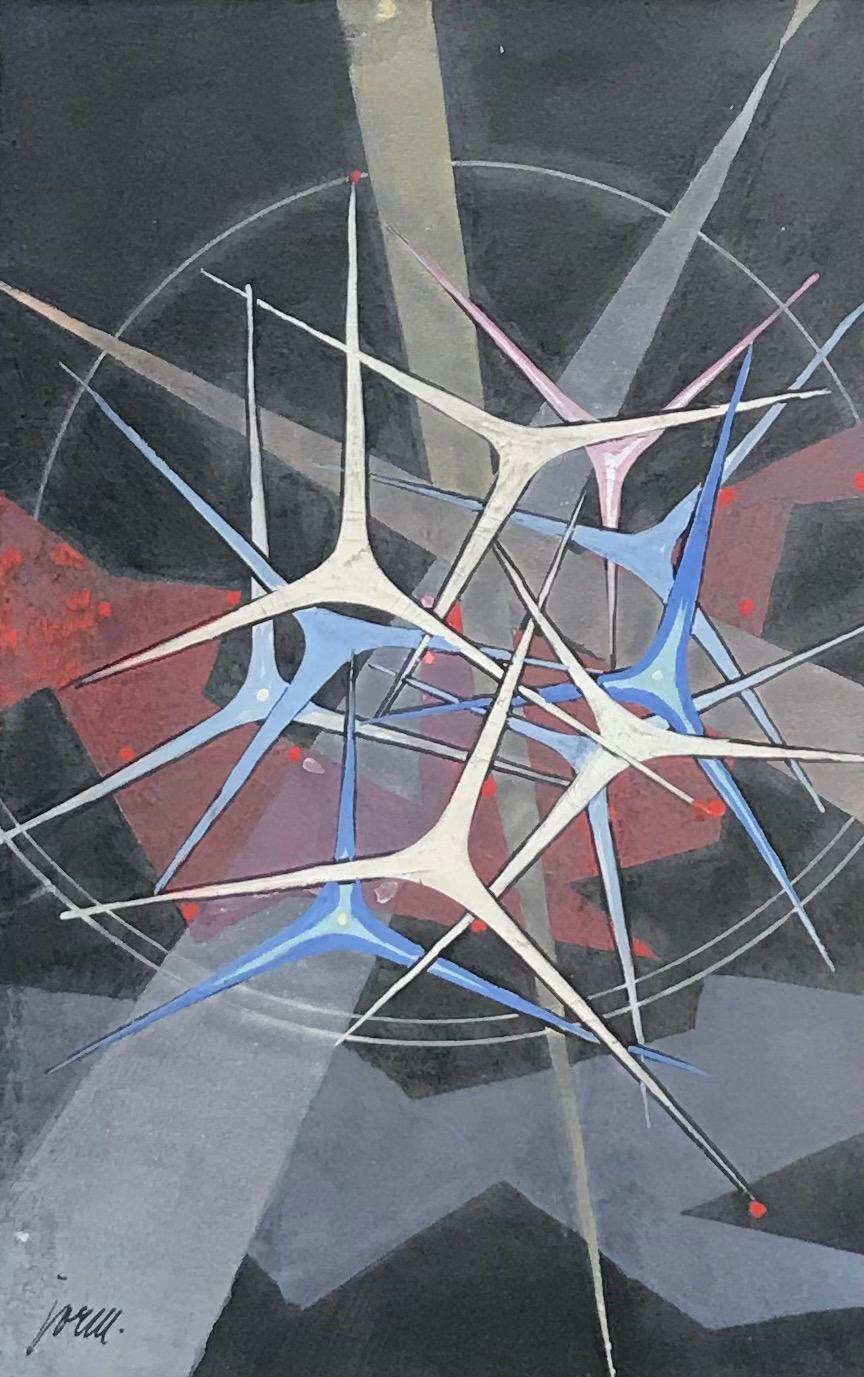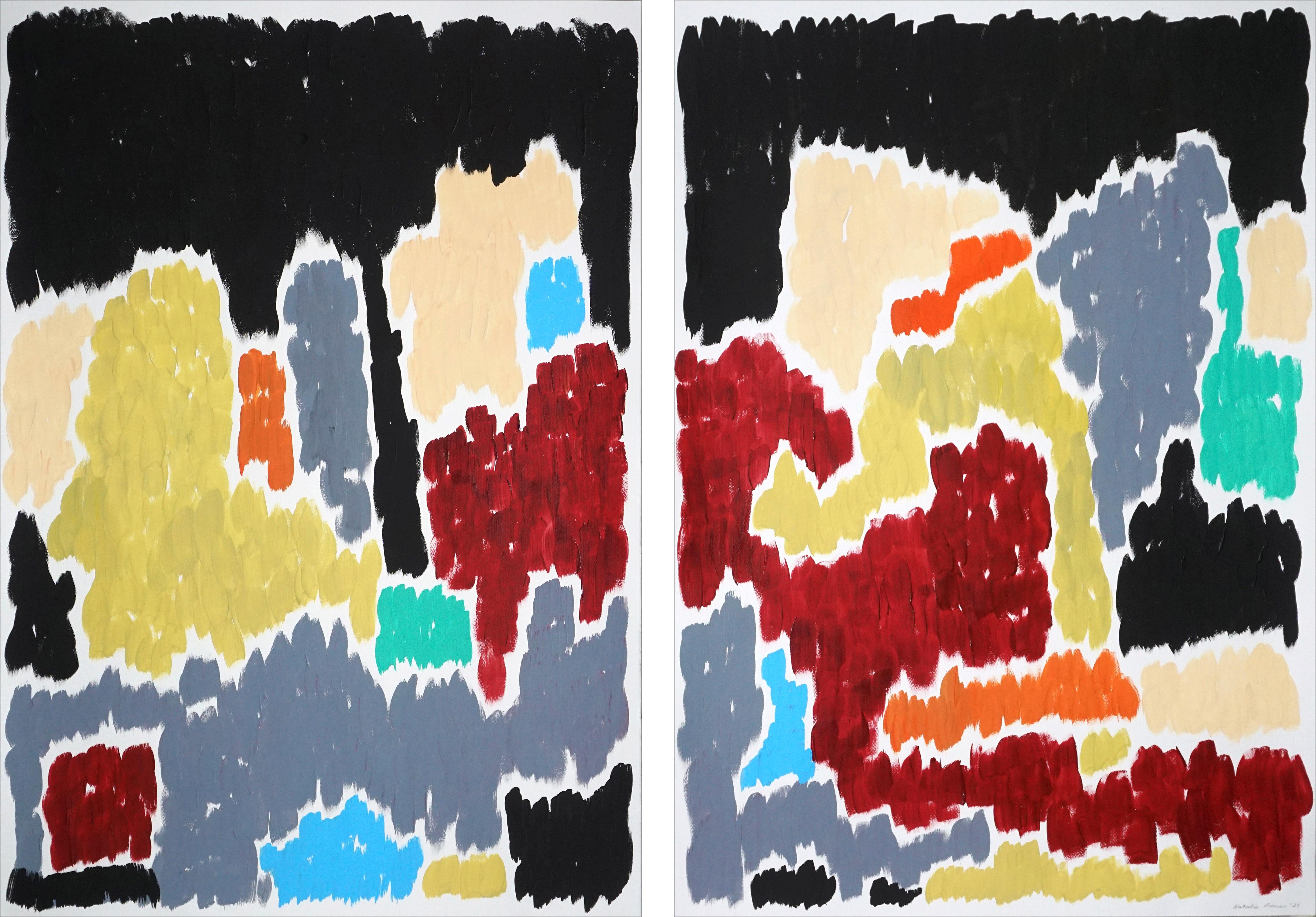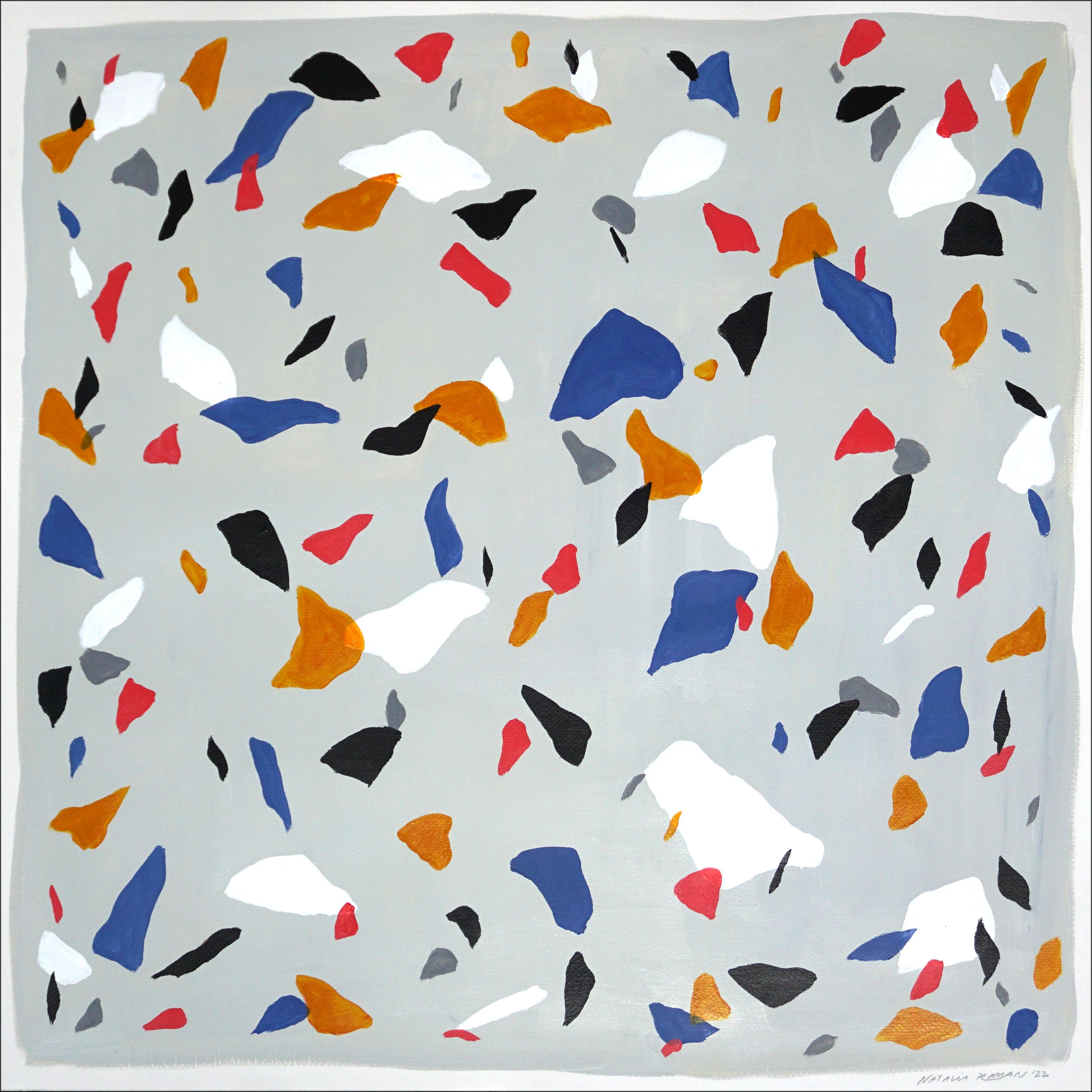Items Similar to Whore by Rene Ricard pink and silver painting with poetry
Want more images or videos?
Request additional images or videos from the seller
1 of 12
Rene RicardWhore by Rene Ricard pink and silver painting with poetry 1990
1990
About the Item
A fluid wash of bubblegum pink fills the surface of this painting. Ricard has written in bright yellow, blue, and vivid silver the following: So how do you be friends w/a whore? Business being business/Ethically, a ho can’t rat on its tricks; so if the ho is hohoing yr husband Damned if you’ll ever find out. March 26.
Whore sharply contrasts the beauty of silver, yellow, and pink with Rene’s pithy, obscene pronouncement. The pink ground is applied in a sheer wash, like Male Cinderella’s background, and the artist’s cursive shimmers in the same silver as One Shoe One You / True Love, Size 3?, and This is not a thanksgiving pumpkin. While Whore shares enticing formal qualities with other works in this group, the text snaps us to cold reality, down into the gutter with a bump. Ricard is happy to visit a fairy tale, but doesn’t stays in the fantasy for long. There’s an intimacy to this work’s smaller scale which compels the viewer to lean in and decode Ricard’s poetry. The artist’s outsized signature is with initials in dark blue, which pop out against that beautiful saturated pink.
Canvas floater frame, in maple with .25 inch moulding.
Whore is part of a group of works dating from 1989-1990 as Rene Ricard prepared for Mal de Fin at the Petersburg Gallery, New York, in 1990, his very first one-man exhibition. Born Albert Napoleon Ricard, he moved to New York in the 1960s at the age of 18. With that relocation, Albert died, and Rene was born. Instantly adopted into Andy Warhol’s glittering orbit, Ricard thrived in the city, with its heady concentration of art, culture, and debauchery. In New York Ricard found the milieu where he would shine.
He acted in underground films, playing Warhol in the artist’s own Andy Warhol Story. He became a renowned poet and writer, published in the Paris Review and Artforum. In typically wry fashion he explained how he became a painter: “I began adding images [to my poetry] because I’ve always liked to draw and paint. And it was hard to find junk-store paintings of the right quality, things that could support some writing, so I just started making the images myself. Unfortunately, people really like that, even though I far prefer just the writing.” Ricard drew on his vast knowledge of literature and art history, weaving these references together with bursts of autobiographical poetry: what the New York Times termed his “seething verbal finesse.”
Ricard, having spent years in the Factory’s milieu, learned from Warhol’s creative strategies. Warhol created images quickly with screen printing, with no regard for perfection. Duplication was the method and the ideology. Ricard, too, worked quickly: urgency was part of his visual language of looped cursive and scribbled colors. He often borrowed a lithographic plate or silkscreen from already-completed works, printing the matrix on canvas or paper to create backgrounds for new works (Size 3’s red printed background may be an example of this). He appropriated thrifted paintings and discarded items such as a pinboard or a piece of insulation, so long as the object in question had a flat surface upon which to work. The two artists were both outsiders to the art world in a sense—Warhol coming from the world of design and Ricard, a bona fide author, but both intuitively understanding how to compel the viewer.
As Warhol anthologized consumerism, Ricard catalogued desire. For example, Size 3 and One Shoe One You feature Ricard’s take on Warhol’s famous shoe drawings which the artist produced in droves. The shoes are labeled with socialites’ and celebrities’ names or by a short musing description. By removing each shoe’s partner, both artists elevated the single shoe into the symbolic realm: for Warhol, each shoe was a character representing an individual, but was also broadly denoting culture. Ricard placed his shoe in the context of Cinderella’s story: a young woman who is orphaned and left to the devices of her evil stepmother. Cinderella is saved after Prince Charming finds her shoe, left behind as she fled the ball at midnight. It’s a story of sadism and suffering, transformation and luck, of late-night parties and hurried exits—very Rene. One Shoe One You reproduces the iconic Disney animated version of Cinderella, with her blue dress, updo, and choker, in olive green and dark grey paint. Around her doubled shadow float a diamond ring and glass slipper. Cinderella stripped of romance is the compact oil paint stunner Whore: with pragmatic musing about a sex worker, pictured in glamorous pink and silver.
Perhaps Ricard could imagine himself as the tragic fairy tale character out past midnight. The artist loved to wear rings and flamboyant fashion. He could be found hobnobbing in the glittering nightlife scene with Andy Warhol and Basquiat, socialites and celebrities, and the next moment stalking the east village in search of a fix or nodding off on endless early morning train rides. Cinderella awaited her savior in the form of Prince Charming, while Rene relied on his own biting wit and charm to keep him afloat, claiming: “I honestly don't need much money. People love to buy me drinks. Hostesses love to feed me. Famous artists lavish me with expensive artworks, and heiresses do the same with jewels that I promptly lose.”
Rene was known for paying bills with paintings and skipping out on debts—had the artist acquired a glass slipper, the precious talisman would certainly have been sold or lost. A stark Nan Goldin portrait pictures Rene, in profile against a spray of cut flowers. He is smoking cocaine through a glass tube, to be discarded like the slipper once broken. He gazes down his aquiline nose, looking elegant even in his debauchery. He is a world away from the baby-faced blond starlet Ricard, photographed at the Factory with Andy Warhol. His swing from day to day between these poles of fame and debasement was as if by cursed enchantment, as Cinderella’s glittering carriage returned to its mundane form after midnight.
But Rene never doubted the power of transformation. In the final paragraph of Ricard’s seminal Basquiat essay “The Radiant Child”, he muses: “We are that radiant child and have spent our lives defending that little baby, constructing an adult around it to protect it from the unlisted signals of forces we have no control over. We are that little baby, the radiant child, and our name, what we are to become, is outside us and we must become “Judy Rifka” or “Jean-Michel” the way I became “Rene Ricard.”
- Creator:Rene Ricard (1946 - 2014, American)
- Creation Year:1990
- Dimensions:Height: 21 in (53.34 cm)Width: 21 in (53.34 cm)Depth: 2 in (5.08 cm)
- Medium:
- Movement & Style:
- Period:
- Condition:In good condition having been in storage in our archive since its creation. Framed in 2024.45000.
- Gallery Location:New York, NY
- Reference Number:1stDibs: LU1211214012862
About the Seller
5.0
Gold Seller
These expertly vetted sellers are highly rated and consistently exceed customer expectations.
Established in 1968
1stDibs seller since 2019
293 sales on 1stDibs
Typical response time: <1 hour
- ShippingRetrieving quote...Ships From: New York, NY
- Return PolicyA return for this item may be initiated within 7 days of delivery.
More From This SellerView All
- Blood: Howard Hodgkin hand painted Abstract Red Brown Coral and BlackBy Howard HodgkinLocated in New York, NYAbstract, large scale red, orange, crimson, black, and pink scene with lines, shapes and hand painted brushstroke texture. This dramatic Howard Hodgkin work is ideal for display in m...Category
1980s Abstract Abstract Prints
MaterialsWatercolor, Gouache, Lithograph
- David Hockney in Hollywood by Howard Hodgkin abstract red watercolor etchingBy Howard HodgkinLocated in New York, NYBright colors and abstract textures highlight two shapes, like a pair of eyes, at the center of this etching with watercolor and pastel. Howard Hodgkin based this print on a trip he...Category
Late 20th Century Abstract Abstract Prints
MaterialsOil Pastel, Watercolor, Etching
- DH in Hollywood (David Hockney) Howard Hodgkin colorful abstract painting framedBy Howard HodgkinLocated in New York, NYHoward Hodgkin based this print on a trip he took to visit his good friend and fellow Petersburg Press collaborator David Hockney in Los Angeles. The mid-eighties saw new levels of abstraction in Hodgkin’s work, building exuberantly off the ambiguous spaces of his earlier work. The artist used six colors of paint, producing a unique depth and texture to each print in this edition. Howard Hodgkin was introduced to the etching technique used in DH in Hollywood at Petersburg Press, where he was a long-time collaborator. Soft-ground etching allowed him to work fluidly and spontaneously, giving his prints the characteristic black brushstrokes seen in this print. Paper 8.4 x 11 in. / 21.3 × 27.9 cm Soft-ground etching (from one plate) with hand coloring in watercolor (orange-red, brown, and green) and oil pastel (red and...Category
Late 20th Century Abstract Abstract Prints
MaterialsOil Pastel, Watercolor, Etching
- The Limp by Rene Ricard abstract poetry paintingBy Rene RicardLocated in New York, NYThe Limp conjures the image of Rene consumed with energy and righteousness, then resignation: "He was pushing the door in, I was pushing him out / He won". The words are scrawled in ...Category
1980s Abstract Abstract Paintings
MaterialsOil, Acrylic, Screen
- Ashes of Roses by Rene Ricard 1989 New York Lower East Side poetry LESBy Rene RicardLocated in New York, NYAshes of Roses is Rene Ricard's mauve-colored map of Rivington Street between Suffolk and Clinton Street, with a white arrow pointing to the word mofongo, indicating a Puerto Rican r...Category
1980s Abstract Paintings
MaterialsOil, Acrylic, Screen
- Rene Ricard Red Blue Nasty, 1989 poetry painting Keith Haring referenceBy Rene RicardLocated in New York, NYFrustration is center stage, written in cursive: "It's one of those days nothing works out right -- bump into any sharp corner – can’t tell flesh from white or brown from…or green fr...Category
1980s Contemporary Abstract Paintings
MaterialsOil, Acrylic, Screen
You May Also Like
- The Four Evangelists, Figure colorful Abstract diptych face and cartoon elementsBy C. DimitriLocated in Brooklyn, NYIn a way, it is a collision of opposites. Two canvases combined to one frame.Category
2010s Abstract Abstract Paintings
MaterialsCanvas, Ink, Oil, Spray Paint, Gouache
- Abstract composition - Gouache on paper 14x22 cmLocated in Geneva, CHWork on paper glued to cardboard Dimensions of the "passe-partout" frame 29 x 22.5 x 0.7 cm Work signed lower right and monogram F.V.S. and dated on the up...Category
1950s Abstract Abstract Paintings
MaterialsOil, Gouache
- Abstract Botanical Art Deco Painting Diptych of Nocturnal Flower Fields, PaperBy Natalia RomanLocated in Barcelona, ES"Nocturnal Flower Fields" is an abstract painting by Spanish artist Natalia Roman. It is a beautiful abstract architectural painting of unique blurry shapes brushstrokes in pastel Ar...Category
2010s Abstract Impressionist Abstract Paintings
MaterialsOil Pastel, Oil, Acrylic, Watercolor, Gouache
- Primary Colors on Gray Terrazzo, Squared Painting on Watercolor Paper, MinimalBy Natalia RomanLocated in Barcelona, ESThis series of hand painted acrylic paintings by Natalia Roman are inspired by the colors and textures of Italian terrazzo tiling. The patterns created combine a variety of vivid col...Category
2010s Abstract Impressionist Abstract Paintings
MaterialsOil Pastel, Oil, Acrylic, Watercolor, Gouache
- Autumn in Provence, Abstract Diptych Landscape, Warm Tones, Floral InspirationBy Natalia RomanLocated in Barcelona, ES"Autumn in Provence" is an abstract painting by Spanish artist Natalia Roman. It is a beautiful abstract architectural painting of unique blurry sha...Category
2010s Abstract Impressionist Abstract Paintings
MaterialsOil Pastel, Oil, Acrylic, Watercolor, Gouache
- Mid-Tone Diagonal Transparency, Geometric Patchwork, Pink, Purple, Black CirclesBy Natalia RomanLocated in Barcelona, ESThis series of paintings by Natalia Roman gathers its inspiration from geometric, minimalist shapes and paintings from the beginning of Modernism, with a special emphasis on Art Deco...Category
2010s Abstract Geometric Abstract Paintings
MaterialsOil Pastel, Oil, Acrylic, Watercolor, Gouache





